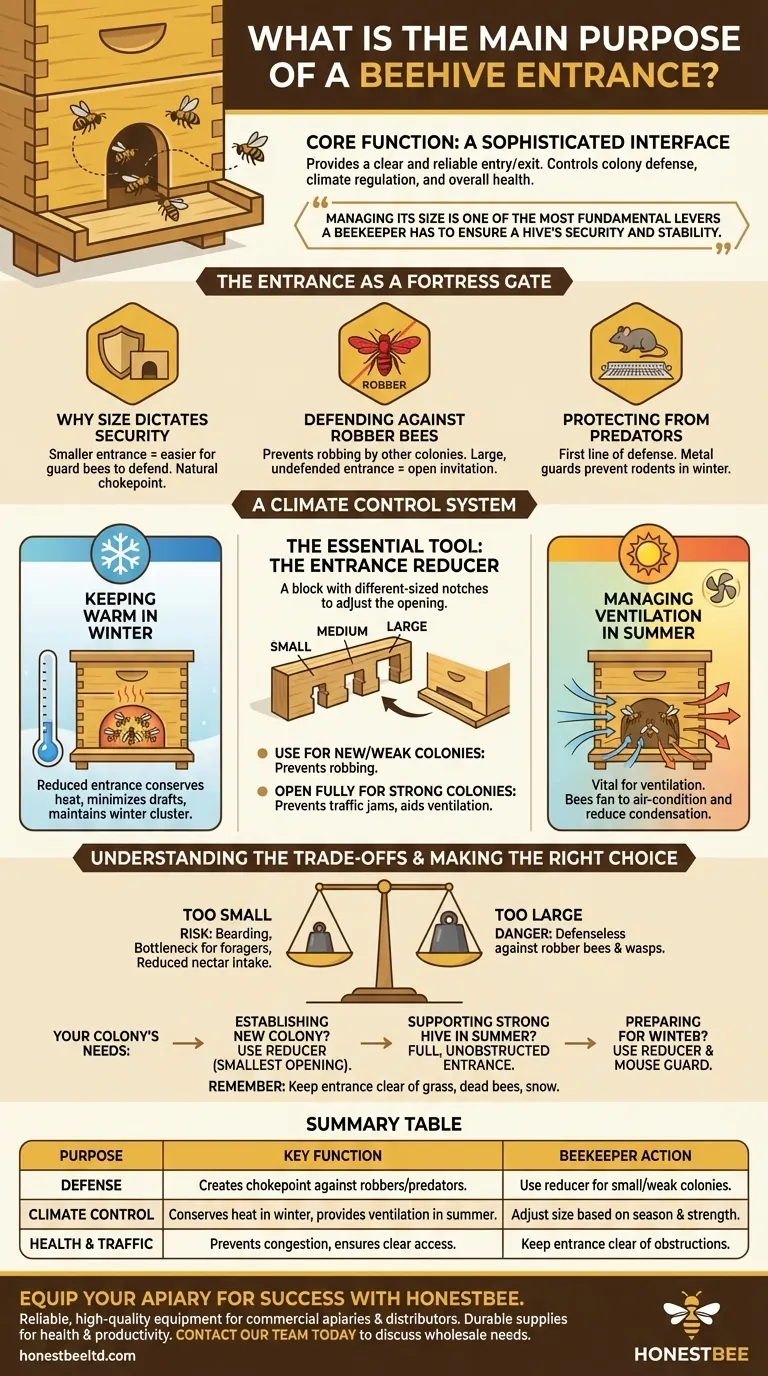At its core, a beehive entrance serves one primary function: to provide the bees with a clear and reliable way to get in and out of their hive. This single opening, however, is far more than a simple doorway; it is a critical control point that directly impacts the colony's defense, climate regulation, and overall health.
The beehive entrance should not be seen as just an opening, but as a sophisticated interface between the colony and the outside world. Managing its size is one of the most fundamental levers a beekeeper has to ensure a hive's security and stability.

The Entrance as a Fortress Gate
A honeybee colony is a rich prize, full of honey, pollen, and brood. This makes it a target for a host of threats, and the entrance is the main point of defense.
Why Size Dictates Security
A smaller entrance is significantly easier for the colony's guard bees to defend. It creates a natural chokepoint, limiting how many invaders can attempt to enter at once.
Defending Against Robber Bees
Other honeybee colonies may try to "rob" a weaker hive of its honey stores. A large, undefended entrance is an open invitation for these robbers, which can quickly overwhelm and destroy a small colony.
Protecting from Predators
The entrance is the first line of defense against larger predators. While a simple wooden reducer offers some protection, specialized metal mouse guards are often necessary to prevent rodents from entering and nesting during the winter.
A Climate Control System
The entrance plays a crucial role in how the bees manage the hive's internal environment, from temperature to airflow.
Keeping Warm in Winter
A reduced entrance helps the colony conserve heat during cold months. It minimizes drafts and reduces the volume of cold air entering the hive, allowing the bees to maintain their winter cluster temperature more efficiently.
Managing Ventilation in Summer
In the heat of summer, the entrance is vital for ventilation. Bees will fan their wings at the entrance to draw cool air in and push hot, humid air out, effectively air-conditioning their home.
Reducing Condensation
Proper airflow, managed at the entrance, helps prevent condensation from building up inside the hive, especially during winter. A top entrance can be particularly effective at allowing moist air to escape.
The Essential Tool: The Entrance Reducer
To manage the strategic functions of the entrance, beekeepers rely on a simple but critical tool.
What is an Entrance Reducer?
An entrance reducer is typically a small, rectangular block of wood that fits into the main entrance on the hive's bottom board. It usually has different-sized notches cut into it, allowing the beekeeper to adjust the opening to be large, small, or fully closed.
When to Reduce the Entrance
Using an entrance reducer is essential for new or weak colonies. With fewer bees, these colonies cannot effectively guard a full-sized opening, making them highly vulnerable to being robbed. Reducing the entrance is also standard practice for winter preparation.
When to Open the Entrance
For a strong, populous colony during the main nectar flow in summer, the entrance should be fully open. This prevents traffic jams of foraging bees and helps with hive ventilation.
Understanding the Trade-offs
Managing the entrance is a balancing act, and incorrect sizing can create problems for the colony.
The Risk of an Entrance That's Too Small
If the entrance is too small for a strong colony during summer, it can lead to "bearding," where a large number of bees cluster on the outside of the hive. It creates a bottleneck for foragers, reducing the amount of nectar they can bring in.
The Danger of an Entrance That's Too Large
Leaving the entrance wide open for a small or developing colony is one of the most common mistakes new beekeepers make. It leaves the hive almost completely defenseless against robber bees and wasps.
The Need for a Clear Path
It is vital to ensure the entrance remains clear of obstructions. Overgrown grass, dead bees, or fallen snow can block the opening, trapping the bees and cutting off ventilation.
Making the Right Choice for Your Colony
Your management of the beehive entrance should adapt to the colony's strength and the time of year.
- If your primary focus is establishing a new colony: Use an entrance reducer set to its smallest opening to give the bees a defensible space.
- If your primary focus is supporting a strong hive in summer: Provide the full, unobstructed entrance to maximize forager traffic and ventilation.
- If your primary focus is preparing for winter: Use an entrance reducer to conserve heat and add a metal mouse guard for protection against rodents.
Ultimately, proper management of the beehive entrance is a cornerstone of responsible and successful beekeeping.
Summary Table:
| Purpose | Key Function | Beekeeper Action |
|---|---|---|
| Defense | Creates a chokepoint for guard bees against robbers and predators. | Use a reducer for small/weak colonies. |
| Climate Control | Conserves heat in winter and provides ventilation in summer. | Adjust size based on season and colony strength. |
| Health & Traffic | Prevents congestion and ensures clear access for foragers. | Keep entrance clear of obstructions like grass or snow. |
Equip your apiary for success with HONESTBEE.
Properly managing your hive entrance is just the beginning. For commercial apiaries and distributors, having reliable, high-quality equipment is fundamental to protecting your investment and maximizing honey production.
HONESTBEE supplies durable beekeeping supplies and equipment through wholesale-focused operations, ensuring your colonies have the best foundation for health and productivity.
Contact our team today to discuss your wholesale needs and learn how our equipment can strengthen your operation.
Visual Guide

Related Products
- Beehive Entrance Reducer Guardian Metal Hive Entrance for Bees
- Multi-Functional Sliding Hive Entrance for Beekeeping
- Steel Round Disc Entrance Reducer for Flexzion Bee Hive Nuc Box Gate
- Professional Reversible Beehive Hive Entrance
- Multi-Functional Rotary Hive Entrance Disc for Beekeeping
People Also Ask
- What are the two functions of the Entrance Reducer? Master Hive Defense and Safe Transport
- What are the different types of entrance reducers available? A Guide to Protecting Your Hive
- How can a Langstroth hive entrance be adjusted? Mimic Natural Bee Preferences for a Healthier Hive
- What happens if you seal an entrance to a bee hive? Avoid a Costly Structural Disaster
- What is the purpose of placing an object in front of the hive entrance after a move? A Guide to Forced Reorientation



















